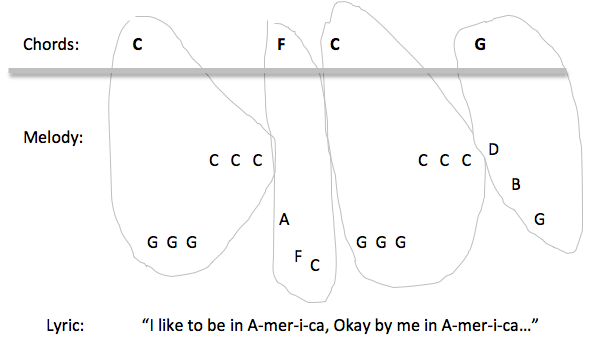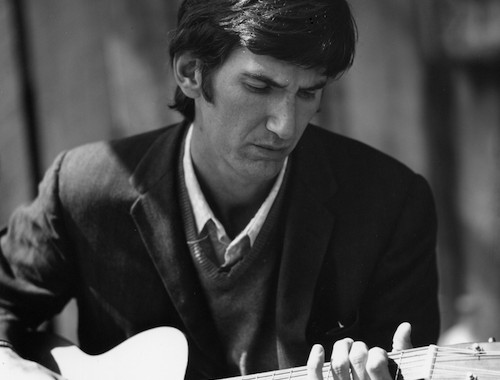A bit of songwriter’s theory for today, and it’s an important lesson especially if you’ve created a melody and are at the stage where you’re adding chords.
If you listen to Leonard Bernstein’s “America”, from “West Side Story“, you’ll notice that practically all the notes from the melody clearly outline the chord that accompanies it:

Melodies that consist only of chord tones leaping about, like the melody for “America,” are rare. Most of the time, you’ll find that melodies move in a stepwise fashion with occasional leaps, like “Blowin’ In the Wind”, for example.
But that can present you with a question: what do you do about notes in your melody that don’t happen to belong to the chord that you’re playing?
 Looking for good songwriting content for your iPad, Kindle, laptop, desktop, or other PDF-reading device? “The Essential Secrets of Songwriting”bundle packages will show you why good songs are good, and how to apply those lessons to your own music. Get the complete Deluxe Bundle of 10 eBooks at a discounted price of $37. Read more..
Looking for good songwriting content for your iPad, Kindle, laptop, desktop, or other PDF-reading device? “The Essential Secrets of Songwriting”bundle packages will show you why good songs are good, and how to apply those lessons to your own music. Get the complete Deluxe Bundle of 10 eBooks at a discounted price of $37. Read more..
Most songs will demonstrate how this is done, because most songs consist of melodies that move up and down from one note to the adjacent one. So that means that occasionally you’ll be singing a note that doesn’t fit the chord.
But just to pull a classic example out of the air, how about Townes Van Zandt’s “If I Needed You.” Give it a listen and you’ll notice that most chords are held for two bars (8 beats) while the melody moves up and down, occasionally by leap and occasionally by step.
The first two bars are all you need to demonstrate the issue: how to fit non-chord notes into a chord. You’ll notice that he plays a B chord through this first phrase, and two of the notes he sings don’t belong to a B chord (shown in red):

In songs like this, it’s fairly easy to hear that the music is organized in alternating strong beats and weak beats. If you tap your foot, you’ll notice that the syllable “need-” is a strong beat, “-ed” is weak, “you” is strong, and so on.
If I need-ed you, would you come to me... (w) S w S w S w S w...
(The uneven spacing in the strong/weak beats is simply to fit the words in)
That understanding of strong versus weak is important when fitting melodies to chords, for this reason: notes that happen on strong beats should usually be chord tones.
And the second part of that thought is this: notes on weak beats don’t need to be chord tones. That’s what you’ll see on the word “to”, represented by the red G# in the diagram above. Because it is a weak beat, you can use either a chord tone or a non-chord tone in your melody, and it should be just fine.
But what about that first E? Why does that work? E doesn’t exist in a B chord, and since the word it’s paired with (“need-“) is a strong beat, it appears to be violating the rule that notes on strong beats should be chord tones.
There is a whole category of exceptions to the rule, called non-chord tones, and of those special exceptions is suspensions. You likely know of so-called sus-chords: Gsus4, for example. That’s a chord that almost always appears on a strong beat, and then you use the strong beat following it to move to a G chord:
Gsus4 G |C... S w S w S...
I use the Van Zandt example because it shows the two main ways that we use melody notes that don’t fit with the chord that’s under it. Most of the time, the non-chord notes that you use will be like the G# shown above: falling on a weak beat, and so you don’t need to worry about it.
And the other category will be non-chord tones that happen on strong beats, and they require special treatment:
- Sing the non-chord tone on the strong beat (like the syllable “need-“)
- Your next melody note should be a chord tone. In other words, non-chord tones need to “resolve” to a chord tone.
If you’re not sure you’re getting this concept, try this article, which describes non-chord tones more fully.
 Written by Gary Ewer. Follow Gary on Twitter.
Written by Gary Ewer. Follow Gary on Twitter.











What about extensions, rather than suspensions? You’ll often hear sixths, sevenths, and ninths on strong beats. I realize that they too usually resolve to a chord tone, but there are certainly successful exceptions.
Hi Drew:
For chords that use extensions, I would include melody notes that use them as part of the chord. In that sense, they’re not non-chord tone.
Cheers,
-Gary